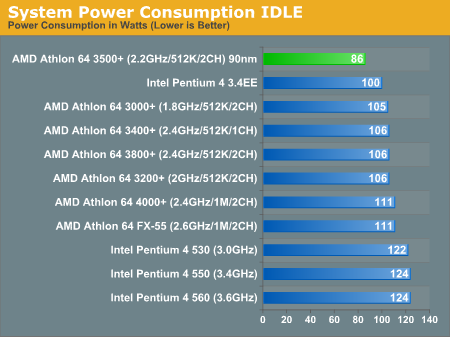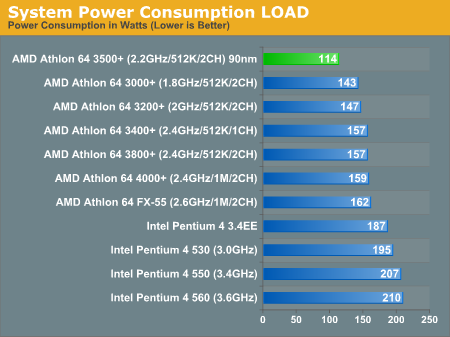AMD Athlon 64 4000+ & FX-55: A Thorough Investigation
by Anand Lal Shimpi on October 19, 2004 1:04 AM EST- Posted in
- CPUs
Power Consumption
To measure power consumption we looked at overall system power consumption and tried to keep as many variables static. There are some basic differences which we cannot get around, mainly that the 925X uses lower voltage DDR-II while the nForce4 uses regular DDR, but for the most part our results were quite controlled. We also included power consumption figures from 130nm Socket-939 Athlon 64 3200+ and 3000+ chips, which as you may know, do not exist. The reason we did this was to show the sharp contrast to the power consumption figures of the 90nm 3500+ we've included in the charts below.
We measured power consumption in two states: idle sitting at the Windows desktop and under load while running our Windows Media Encoder 9 test, which proved to be one of the most strenuous CPU tests we ran as it pretty much isolated the CPU subsystem.
At idle, the 130nm Athlon 64s all consume just about the same amount of power, with the 90nm Pentium 4s doing a little more. But what's truly impressive is the 90nm Athlon 64 3500+, drawing less power than any of the other chips at idle - by a significant margin.

Under load the situation is no different; because of the fact that AMD didn't change anything architecturally (nothing major at least) with the 90nm shrink, the Athlon 64 got what the Pentium 4 should have received with the move down to 90nm - much lower power consumption. However, tack on 32-bit ALUs (as opposed to the 16-bit ALUs in the Northwood Pentium 4), a much longer and more power hungry pipeline as well as logic to support it, and you're looking at a much more power hungry chip. The 90nm Athlon 64 does not suffer this same fate and thus is almost a lower power chip compared to the competition here.











89 Comments
View All Comments
Live - Tuesday, October 19, 2004 - link
Splendid reading! This site is doing a great job right now. I really would love more of these very informative articles that help you so at seeing the big picture.A really helpful article.
Disorganise - Tuesday, October 19, 2004 - link
I’m a bit disappointed by you inconsistency…The comparison with Intel over who wins….slightly inconsistent but no biggie.
What really is bad though, is the penultimate page – is socket 939 worth it?
I agree it is but…..
You’ve taking an identical chip and found it about 5% quicker than on socket 754. OK, no problem. But AMD have wacked a whopping 12% increase in rating, to 3800+ from 3400+. It doesn’t gel, the numbers don’t work.
The 3800+ is also more expensive than the 3400+ to the tune of about 250% here in Australia and about 220% over there in the U.S. a 5% increase in performance does not warrant a doubling in price.
Dave
at80eighty - Tuesday, October 19, 2004 - link
way to go Anand...excellently comprehensive article.../waiting for those HDD articles you promised : p
SLIM - Tuesday, October 19, 2004 - link
Going along with what #6 said:Athlon 64 4000+ - 2.4GHz - 1MB - 128-bit
Athlon 64 3800+ - 2.4GHz - 512KB - 128-bit
Athlon 64 3400+ - 2.4GHz - 1MB - 64-bit <---should be a socket 754 3700+ right?
Athlon 64 3400+ - 2.4GHz - 512KB - 64-bit
Athlon 64 FX-53 - 2.4GHz - 1MB - 128-bit
SLIM
ViRGE - Tuesday, October 19, 2004 - link
#12, even GPUs aren't going anywhere fast. There's still a shortage of something or other needed to make the Ultra/PE parts, and there isn't a planned refresh for 2004. ATI/Nvidia have another speed grade of RAM to jump to(1.6ghz GDDR3), and can die-shrink down to 90nm once TSMC gets there, but they're so close to CPUs right now, they're destined to hit the same wall too.Anand, someone has been a busy beaver.;-) That was a long, but well thought out and informative article; you've basically written the definitive CPU article for now until the multicores come out.
Tides - Tuesday, October 19, 2004 - link
Ah I read the conclusion wrong.Tides - Tuesday, October 19, 2004 - link
why is this site putting down an amd performance gain and making excuses for intel at the same time.Doormat - Tuesday, October 19, 2004 - link
Its a shame the processor wars are coming to an end. I see dual core as neat, but a dud performance wise. It'll be another year or two before the GPU wars start to die out... hmmm..-CPU performance levels off
-HD capacity levels off
The only interesting stuff going on is GPU stuff.
dvinnen - Tuesday, October 19, 2004 - link
Best artical from Anandtech I've read in a long time. Good job Anand.skiboysteve - Tuesday, October 19, 2004 - link
wait nevermind, you put your comments ABOVE the graphs. threw me off cause this isnt what you usualy do...